
INTRODUCTION
The Cocoa Nut is, of all Palms, most deservedly valued as one of the greatest of the many blessings showered down by a bountiful Providence upon the inhabitants of a tropical clime. Thomas Treloar,
The Prince of Palms, 1852

HISTORY
The earliest references to the coconut (cocos nucifera L.) are in ancient Sanskrit texts, where it is referred to as kalpavriksha, meaning tree which gives everything you need, showing the coconuts many uses were recognised and appreciated from early times. It is still revered in Indian religion and used in Hindu ceremonies, representing good luck and prosperity.
The coconut appears to have originated in the islands of the south Pacific, from where it spread to southern India, although its distribution route and indeed its origin are debated. A recent study has examined the DNA of coconuts and identified two distinct types, one found in the Pacific basin between Asia and America and the other in the Indo-Atlantic basin between Asia and the Caribbean via Western Africa, which suggests that the coconut was first cultivated in Asia and spread both east and west from there.

It is likely that the coconut was carried to other lands by seafarers plying their way along ancient trade routes. In the account of Sinbads 5th voyage (based on the adventures of Eastern traders in the 8th9th centuries) Sinbad describes how he was shown a method of harvesting coconuts by throwing stones at the apes in the palm trees the apes out of revenge threw cocoa-nuts at us fast by this stratagem we filled our bags with cocoa-nuts. Sinbad was collecting these coconuts to trade in exchange for pepper with the nearby island.
It is possible, however, that the coconut, with its light waterproof shell, could have spread independently by floating across the sea until it reached another shore and rooted itself. By whatever means, by the 6th century AD the coconut is thought to have arrived in Egypt from India, and by medieval times trading routes had bought it as far as western Europe. The exotic coconut was such a rarity that it was used as an art material by jewellers who removed the outer husks, polished the shell until it was smooth and decorated it with precious gems. A beautiful example of a coconut cup can be seen in the Ashmolean museum in Oxford. These cups were signs of status in wealthy families and were passed down the generations. The coconut was becoming more widespread.
Marco Polo, the Venetian explorer, was familiar with the coconut when he encountered it on his travels in Sumatra in 1210, referring to it as nux indica (the Indian nut). He writes that the cavity of this pulp is filled with a liquor clear as water, cool, and better flavoured and more delicate than wine or any other kind of drink whatever. In March 1521 the Italian explorer Ludivico di Varthema visited India and wrote about the tenga tree (the Malayalim name for the coconut) which he called the most fruitful tree in the world: Ten useful things are derived from this tree. The first utility is wood to burn; nuts to eat; ropes for maritime navigation; thin stuffs which, when they are dyed, appear to be made of silk; charcoal in the greatest perfection; wine; water; oil and sugar; and with its leaves which fall, that is when a branch falls, they cover the houses Were I to declare to you in what manner it accomplishes so many things you would not believe it, neither could you understand it. It is generally accepted that the coconut first got its modern name from Portuguese explorers in the 16th century. They called the fruit coco, which means head, because the shell looks like a face with its three holes suggesting eyes and mouth.
Subsequently the fruit became known as the coco nut. It is probable that the Portuguese and Spanish explorers took the coconut to the New World with them, although it was still rare in the 19th century, as an American missionary, writing from Ceylon (Sri Lanka) notes that he will make some remarks about [the palmyra tree and] the cocoa-nut tree, neither of which I believe is in the United States. By the end of the 19th century, the mighty British empire was transporting goods around the world, and the coconut now became a familiar sight, initially as an exotic fruit to eat, and then, as it became more common, in manufacturing. The by-products were used in a variety of industries, for example the manufacture of coir matting, which achieved fame when it was used as a floor covering at St Georges Chapel, Windsor, at the christening of the future King Edward VII in 1842. HEALTH BENEFITS Regarded for centuries as an essential foodstuff in tropical countries, the coconut was for years not considered particularly healthy due to the levels of saturated fat it contains. Coconuts do contain a significant amount of fat, but the fats are what are known as medium-chain triglycerides (MCTs), which are converted into energy quickly rather than being stored as fat. This energy boost, which helps with physical performance, is similar to that given by carbohydrates, but without the weight gain and insulin-spike which can lead to health problems, especially in diabetics.
Studies have also shown that eating coconut can increase thyroid activity, which helps with stabilising weight and boosts the immune system. MCTs also help boost the bodys ketone levels which help maintain good brain health and avoid neurological problems such as dementia. Around half the fat in the coconut is a fat called lauric acid which is converted by the body into an antibacterial and antiviral compound called monolaurin which strengthens immunity and fights infection and viruses. Lauric acid does raise bad cholesterol levels but to a greater degree it boosts good cholesterols which prevent blood vessels becoming blocked, thus countering the risk of heart disease. It is advised to eat coconuts in moderation though, due to this high fat content. Coconuts are also full of vitamins including Vitamin C, essential for boosting the immune system, and Vitamin E, which is needed to promote new cell development and helps maintain good skin health.
They also contain the B vitamins B1, B 3, B5 and B6, which work together to release energy from food and keep the nervous system, blood cells and skin healthy.  Coconuts are also rich in minerals including iron, potassium, calcium, selenium and zinc, all essential to good health. Potassium helps fight depression and regulates heart rate as well as being good for digestion. Calcium is good for bone health, while zinc and selenium help repair cells and fight infection. Iron is an essential mineral as it aids the production of red blood cells which carry oxygen round the body. Coconut water is high in electrolytes which are essential for hydration, digestion and a good metabolism.
Coconuts are also rich in minerals including iron, potassium, calcium, selenium and zinc, all essential to good health. Potassium helps fight depression and regulates heart rate as well as being good for digestion. Calcium is good for bone health, while zinc and selenium help repair cells and fight infection. Iron is an essential mineral as it aids the production of red blood cells which carry oxygen round the body. Coconut water is high in electrolytes which are essential for hydration, digestion and a good metabolism.

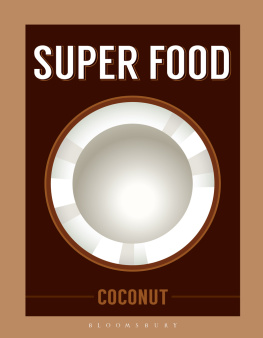


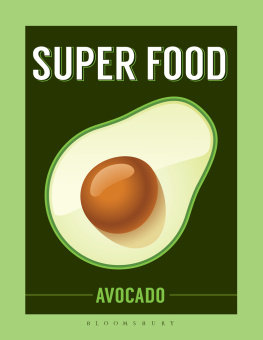

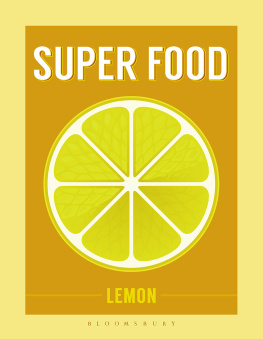
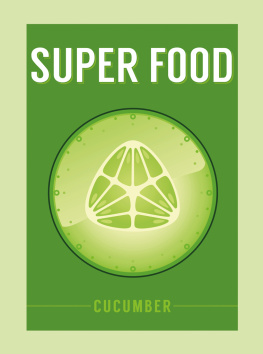
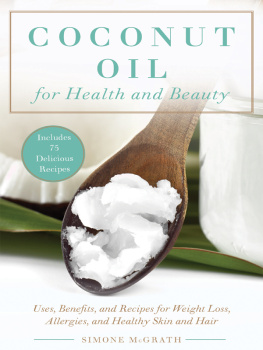
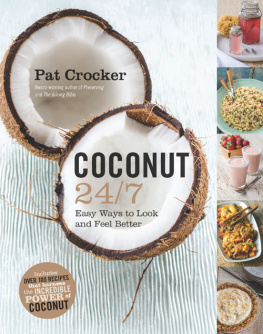

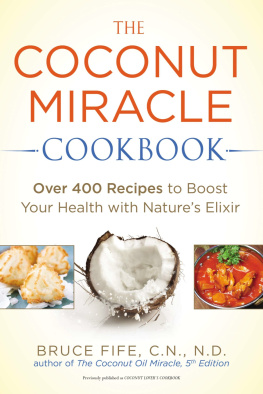

 C ONTENTS
C ONTENTS
 INTRODUCTION The Cocoa Nut is, of all Palms, most deservedly valued as one of the greatest of the many blessings showered down by a bountiful Providence upon the inhabitants of a tropical clime. Thomas Treloar,
INTRODUCTION The Cocoa Nut is, of all Palms, most deservedly valued as one of the greatest of the many blessings showered down by a bountiful Providence upon the inhabitants of a tropical clime. Thomas Treloar, HISTORY The earliest references to the coconut (cocos nucifera L.) are in ancient Sanskrit texts, where it is referred to as kalpavriksha, meaning tree which gives everything you need, showing the coconuts many uses were recognised and appreciated from early times. It is still revered in Indian religion and used in Hindu ceremonies, representing good luck and prosperity.
HISTORY The earliest references to the coconut (cocos nucifera L.) are in ancient Sanskrit texts, where it is referred to as kalpavriksha, meaning tree which gives everything you need, showing the coconuts many uses were recognised and appreciated from early times. It is still revered in Indian religion and used in Hindu ceremonies, representing good luck and prosperity. The coconut appears to have originated in the islands of the south Pacific, from where it spread to southern India, although its distribution route and indeed its origin are debated. A recent study has examined the DNA of coconuts and identified two distinct types, one found in the Pacific basin between Asia and America and the other in the Indo-Atlantic basin between Asia and the Caribbean via Western Africa, which suggests that the coconut was first cultivated in Asia and spread both east and west from there.
The coconut appears to have originated in the islands of the south Pacific, from where it spread to southern India, although its distribution route and indeed its origin are debated. A recent study has examined the DNA of coconuts and identified two distinct types, one found in the Pacific basin between Asia and America and the other in the Indo-Atlantic basin between Asia and the Caribbean via Western Africa, which suggests that the coconut was first cultivated in Asia and spread both east and west from there.  It is likely that the coconut was carried to other lands by seafarers plying their way along ancient trade routes. In the account of Sinbads 5th voyage (based on the adventures of Eastern traders in the 8th9th centuries) Sinbad describes how he was shown a method of harvesting coconuts by throwing stones at the apes in the palm trees the apes out of revenge threw cocoa-nuts at us fast by this stratagem we filled our bags with cocoa-nuts. Sinbad was collecting these coconuts to trade in exchange for pepper with the nearby island.
It is likely that the coconut was carried to other lands by seafarers plying their way along ancient trade routes. In the account of Sinbads 5th voyage (based on the adventures of Eastern traders in the 8th9th centuries) Sinbad describes how he was shown a method of harvesting coconuts by throwing stones at the apes in the palm trees the apes out of revenge threw cocoa-nuts at us fast by this stratagem we filled our bags with cocoa-nuts. Sinbad was collecting these coconuts to trade in exchange for pepper with the nearby island.  Coconuts are also rich in minerals including iron, potassium, calcium, selenium and zinc, all essential to good health. Potassium helps fight depression and regulates heart rate as well as being good for digestion. Calcium is good for bone health, while zinc and selenium help repair cells and fight infection. Iron is an essential mineral as it aids the production of red blood cells which carry oxygen round the body. Coconut water is high in electrolytes which are essential for hydration, digestion and a good metabolism.
Coconuts are also rich in minerals including iron, potassium, calcium, selenium and zinc, all essential to good health. Potassium helps fight depression and regulates heart rate as well as being good for digestion. Calcium is good for bone health, while zinc and selenium help repair cells and fight infection. Iron is an essential mineral as it aids the production of red blood cells which carry oxygen round the body. Coconut water is high in electrolytes which are essential for hydration, digestion and a good metabolism.